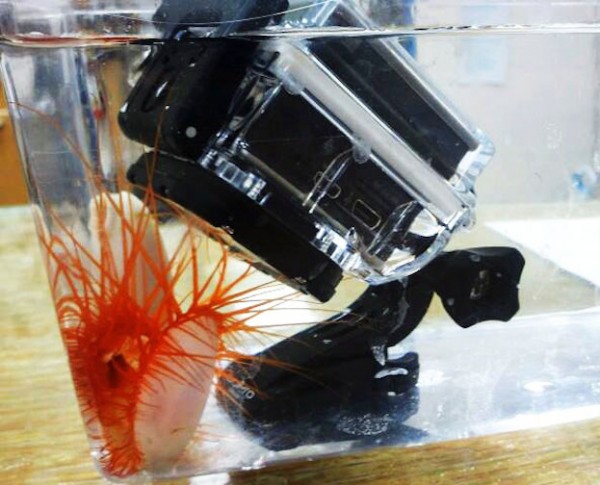Mystery behind Weird 'Disco Clam' Revealed
| Marco Foronda | | Jan 05, 2015 09:44 AM EST |
(Photo : Lindsey Dougherty/Live Science) A GoPro camera records the flashes of a disco clam in an aquarium.
Native to the Indo-Pacific region, the tiny disco clam (Ctenoides ales) gives a spectacular underwater light show that scares away predators and traps light-loving prey, a new study discovered.
The clam uses nanoparticles of silica to reflect light in the ocean depths. This clam is unique because the kind of control it displays when generating light is something that hasn't been observed before.
Like Us on Facebook
Clams use tiny spheres of silica chemically similar to window glass. The disco clam has two fleshy mantle lips the color of a ripe mango.
It isolates the silica on one side of these lips, in the soft fold the clam uses to filter feed. The other side of the lip, which is reddish, absorbs light. The flashing colors take place when the mollusk rolls up and unfolds each side simultaneously, several times a second.
"We don't know of anything that is quite like the disco clam," Lindsey Dougherty, a biologist at the University of California Berkeley and the lead author of the study.
The study also discovered the clam has sulfur in its fleshy lips and tentacles. Scientists suspect the sulfur is converted into a distasteful substance to keep predators at bay.
Previously, scientists believed the bivalve was bioluminescent, an effect caused by light-emitting chemical reactions, thus giving them their characteristic glow.
To learn more about the disco clams, researchers placed the mollusc in an aquarium and used a floating styrofoam lid to imitate a looming predator. The styrofoam scared the clams that considered the thing its enemy.
The clams' flash rate jumped from 1.5 times a second to 2.5 flashes a second when the lid was nearby, researchers found.
The study was presented at the 2015 annual conference of the Society for Integrative and Comparative Biology in the United States. It was also published in the Journal of the Royal Society Interface.
Tagsdisco clam, Ctenoides ales, marine creatures, underwater light show, clams
©2015 Chinatopix All rights reserved. Do not reproduce without permission
EDITOR'S PICKS
-

Did the Trump administration just announce plans for a trade war with ‘hostile’ China and Russia?
-

US Senate passes Taiwan travel bill slammed by China
-

As Yan Sihong’s family grieves, here are other Chinese students who went missing abroad. Some have never been found
-

Beijing blasts Western critics who ‘smear China’ with the term sharp power
-

China Envoy Seeks to Defuse Tensions With U.S. as a Trade War Brews
-

Singapore's Deputy PM Provides Bitcoin Vote of Confidence Amid China's Blanket Bans
-

China warns investors over risks in overseas virtual currency trading
-

Chinese government most trustworthy: survey
-

Kashima Antlers On Course For Back-To-Back Titles
MOST POPULAR
LATEST NEWS
Zhou Yongkang: China's Former Security Chief Sentenced to Life in Prison

China's former Chief of the Ministry of Public Security, Zhou Yongkang, has been given a life sentence after he was found guilty of abusing his office, bribery and deliberately ... Full Article
TRENDING STORY

China Pork Prices Expected to Stabilize As The Supplies Recover

Elephone P9000 Smartphone is now on Sale on Amazon India

There's a Big Chance Cliffhangers Won't Still Be Resolved When Grey's Anatomy Season 13 Returns

Supreme Court Ruled on Samsung vs Apple Dispute for Patent Infringement

Microsoft Surface Pro 5 Rumors and Release Date: What is the Latest?










